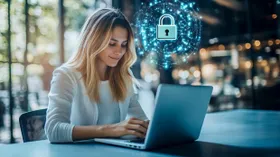The CIA Triad in Cybersecurity: Explained for Business Leaders
Learn how the CIA Triad provides you with a vital framework for strengthening your cybersecurity and safeguarding sensitive information.
Published April 5, 2025.

The CIA Triad, referring to confidentiality, integrity, and availability, still remains the bedrock of a solid cybersecurity strategy. These principles are essential for safeguarding your sensitive information, ensuring data accuracy, and maintaining system functionality. As cyber threats grow, businesses need a comprehensive approach that goes beyond just compliance. Understanding the CIA Triad empowers you to protect your data and systems from both internal and external threats, ensuring resilience in a rapidly evolving digital landscape.
» Want to strengthen your cybersecurity strategy? Find out how GRSee can help
The 3 Principles of the CIA Triad
1. Confidentiality: Protecting Sensitive Information
Confidentiality is the cornerstone of cybersecurity, ensuring that sensitive information—such as personal data, financial records, or intellectual property—is protected from unauthorized access or exposure by implementing access controls, encryption, and authentication mechanisms
To maintain confidentiality, implement the following techniques:
- Data encryption: Encrypting data at rest and in transit ensures that even if the data is intercepted, it cannot be understood without the proper decryption key. Advanced encryption protocols like AES-256 provide robust security, making it difficult for unauthorized users to decrypt the data without significant computing power and the correct decryption key.
- Access control: Implementing role-based access control (RBAC) ensures that employees or users can only access the information they need for their tasks, minimizing the risk of unauthorized access. By restricting access based on roles, organizations can reduce the likelihood of insider threats or accidental data exposure.
- Multi-factor authentication (MFA): Adding multiple layers of authentication strengthens security by combining passwords with additional factors like biometrics or one-time codes, making it much harder for attackers to bypass security even if a password is compromised.
» Understand the benefits of a secure development lifecycle
Example: The Target data breach in 2013 exposed over 40 million credit card numbers due to weak internal security measures. This not only led to significant financial losses but also caused severe damage to Target’s reputation, demonstrating the critical importance of confidentiality in cybersecurity.
» Did you know that attackers use encryption as well? Here's how to deal with ransomware
2. Integrity: Ensuring Trustworthiness of Data
Integrity refers to the accuracy, completeness, and trustworthiness of data, ensuring it remains consistent and unaltered during storage or transmission, whether accidentally or maliciously.
To maintain data integrity, implement the following techniques:
- Checksums and hash functions: These mathematical tools detect changes in data by comparing the calculated value of the data before and after transmission. If the values do not match, it indicates that the data may have been altered.
- Data validation: Regularly validating data against predefined rules ensures it remains consistent and accurate over time. This process involves comparing data inputs to expected formats or ranges to detect any potential errors or malicious modifications.
» Don't leave it too late: Here are the disasters you can avoid by tackling cybersecurity on time
Example: In 2017, Equifax faced a catastrophic data breach that compromised the personal information of over 145 million individuals due to a failure to maintain integrity. The breach occurred when Equifax neglected to apply a known patch for a vulnerability in the Apache Struts web application framework, leaving their systems vulnerable to exploitation.
» Want to ensure you security? Here are the standards you should meet
3. Availability: Ensuring Continuous Data Access
Availability ensures that systems, applications, and data are accessible when needed, especially in today's 24/7 business environment where downtime can lead to financial losses, loss of customer trust, and reputational damage.
To maintain availability, implement the following techniques:
- BCP and DRP plans: Business continuity plans (BCP) and disaster recovery plans (DRP) are essential to ensuring a business can continue operations during unexpected disruptions. A BCP outlines steps for maintaining operations during a crisis, while a DRP focuses on restoring IT infrastructure and data access.
- Redundancy and failover systems: Set up backup systems and failover mechanisms to guarantee quick switching during system failures or disruptions. This ensures minimal downtime and continuous availability of critical services, even in case of hardware or software failure.
- Proactive security measures: Deploy firewalls, DDoS protection, load balancers, and traffic monitoring systems to maintain robust network and application security. These measures also mitigate risks from external threats and ensure seamless load distribution across servers.
Real-world examples of availability failures include distributed denial-of-service (DDoS) attacks, where attackers flood a network with traffic and cause it to crash. Such attacks can take critical systems offline, resulting in significant operational disruptions and financial losses.
» Here are some cyber tips for your startup plan
» Interested in cybersecurity? Here's how cybersecurity has evolved
Challenges in Implementing the CIA Triad and How to Overcome Them
While the CIA Triad is crucial for securing data, implementing it across diverse business environments can pose challenges. Organizations must manage increasing complexity across platforms, locations, and distributed teams. The growing reliance on cloud services and the rapid pace of technological evolution make it harder for businesses to maintain consistency in their cybersecurity efforts.
| Challenge | Description | Solution |
|---|---|---|
| Distributed infrastructure | As businesses operate across multiple platforms and geolocations, managing confidentiality, integrity, and availability becomes complex. | Companies need centralized policies and monitoring systems to keep track of all environments and data flow. |
| Rapid technological advancements | The pace of innovation often outstrips the ability of security teams to integrate new solutions. | Organizations must continuously adapt, train staff, and update their tools to ensure they remain effective against the latest threats. |
| Compliance and regulatory requirements | Navigating complex and ever-changing regulations across various regions can create confusion for businesses. | Building a flexible, compliance-oriented framework helps ensure the CIA Triad principles are enforced consistently across jurisdictions. |
| Cloud service dependencies | Relying on third-party cloud providers can add additional layers of complexity. | Organizations must evaluate the security measures of these vendors to ensure they align with the CIA Triad principles. |
» Learn why the cloud might not be safe anymore
Implement the CIA Triad With GRSee
At GRSee, we prioritize helping you implement the CIA Triad into your cybersecurity frameworks, ensuring comprehensive protection against evolving threats. By focusing on these three core principles, we provide tailored solutions that address all aspects of data security:
- Gap assessments: We perform in-depth evaluations to identify and fix vulnerabilities related to confidentiality, integrity, and availability. Our main focus is always the data—its origination points, where it travels, and how it's protected.
- Continuous compliance support: We offer ongoing monitoring to ensure businesses maintain strong security practices over time and adapt to new threats as they emerge.
- vCISO and PCI DSS audits: Our virtual CISO services and PCI DSS audits provide expert support, helping organizations build and maintain a resilient cybersecurity infrastructure that integrates the CIA Triad principles effectively.
GRSee's approach empowers businesses to move beyond mere compliance by developing adaptable, long-term security strategies that protect sensitive data, enhance trust, and reduce risks. With our assistance, your organization will be better equipped to tackle future cyber threats.
» Set a FREE session with our experts to help you strengthen your security with CIA Triad principles





